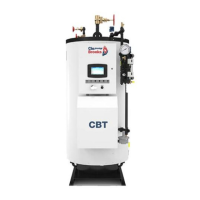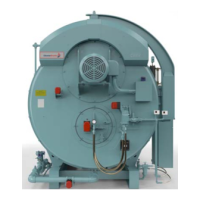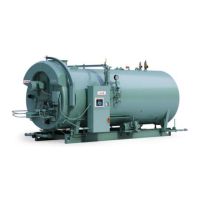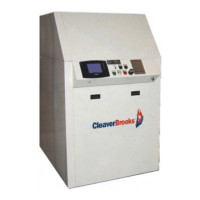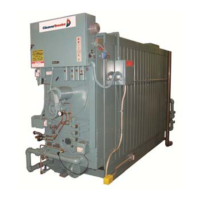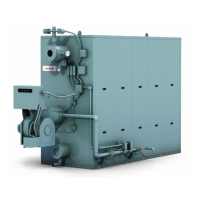750-91 (revised 2009)
Model CB-LE Packaged Boiler Manual
3-11
3.8 — Blowdown: Steam Boiler
Scale has a low heat transfer value and acts as an insulation barrier. Scale retards heat transfer, which not only
results in lower operating efficiency, and consequently higher fuel consumption, but more importantly, can cause
overheating of boiler metal. Overheating of boiler metal can result in tube failures or other pressure vessel metal
damage and lead to boiler down-time and costly repairs.
Scale is caused primarily be calcium and magnesium salts, silica, and oil. Any calcium and magnesium salts in the
boiler water are generally precipitated by the use of sodium phosphate, along with organic materials, to maintain the
precipitates or “sludge” in a fluid form. The solids such as sodium salts and suspended dirt don not readily form
scale. But as the boiler water boils off as relatively pure steam, the remaining water is thickened with the solids. If
the concentration is permitted to accumulate, foaming and priming will occur and the sludge can cause harmful
deposits that bring about overheating of the metal.
The lowering or removal of the concentration requires the use of boiler water blowdown. The two principal types
of blowdown are intermittent manual blowdown and continuous blowdown.
3.8.1 — Intermittent Manual Blowdown
Manual or sludge blowdown is necessary for the operation of the boiler regardless of whether or not continuous
blowdown is employed.
The blowdown tappings are located at the bottom or lowest part of the boiler in order to lower the dissolved solids
in the pressure vessel water, and to remove a portion of the sludge that accumulates in the lower part of the vessel.
Equipment generally consists of a quick opening valve and a shutoff valve. The valves and necessary piping are not
normally furnished with the boiler, but supplied by others. All piping must be to a safe point of discharge. Piping
must be properly supported and free to expand.
3.8.2 — Continuous Blowdown
Continuous blowdown is used in conjunction with a surface blow-off tapping (furnished on 60” diameter and
larger units) and is the continuous removal of concentrated water.
The surface blow-off opening, when furnished, is on the top center line of the pressure vessel. It is provided with
an internal collecting pipe terminating slightly below the working water level for the purpose of skimming surface
sediment, oil, or other impurities from the surface of the pressure vessel water.
A controlled-orifice valve is used to allow a continual, yet controlled, flow of concentrated water.
Periodic adjustments are made to the valve setting to increase or decrease the amount of blowdown in accordance
with the test analysis.
The flow control valve and piping are generally provided by others. All piping must be to a safe point of discharge.
3.8.3 — Frequency of Manual Blowdown
When continuous blowdown is utilized, manual blowdown is primarily used to remove suspended solids or sludge.
The continuous blowdown removes sediment and oil from the surface of the water along with a prescribed amount
of dissolved solids.
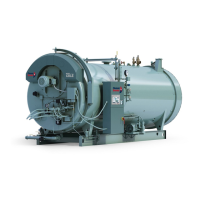
